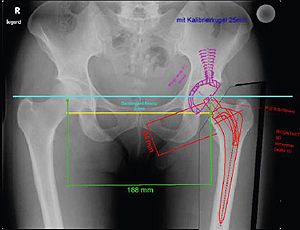



Publié le, 30.08.2022

Precision planning of hip operations with advanced digital tools
Replacing a hip joint with a prosthesis requires careful pre-operative planning. Legally mandated planning and related documentation require a true-to-scale radiograph. Many hospitals have adopted cutting-edge technology and abandoned printed radiographs and pencil-and-ruler planning procedures. Modern institutions with specialties like orthopedics, general surgery, and spinal surgery (which commonly implant hip and knee prostheses) increasingly turn to digital planning solutions.
« mediCAD® » is an advanced, computerized planning system in use around the world. With this solution, the surgeon uses common digital radiographs to plan prostheses entirely on a computer screen.
The benefits of this approach are significantly faster planning, higher planning quality, and improved documentation. As of mid-2012, more than 600 hospitals in Germany use this planning system. The Bethanien Zeisigwald Clinics in the city of Chemnitz are just one example. Surgeons at these locations perform approximately 400 cement-free primary total hip endoprostheses every year.
hectec GmbH of southern Germany has been continuously developing its « mediCAD Classic » planning solution since 1999. Since that time it has gained certifications and approvals around the world. The most recent version 2.50 of its planning program for orthopedic surgeons and hospitals has been significantly expanded and aestheticaly refreshed.

The new version contains more than 100 new functions and changes. Automated workflows and revised procedures save additional time. Surgeons who use mediCAD® to plan hip joints sit at a CAD screen and follow procedures similar to those of an industrial designer, architect, or technical draftsman. In hip endoprosthetic procedures, ligamentary stability is of less concern, so pre-operative planning can be largely standardized and performed effectively on a screen. However, CAD planning is also useful for knee prostheses, particularly revision operations and when planning corrective osteotomies.
Planning is performed in a few simple steps.
 The new femoral head’s center of rotation is likewise established directly on the screen. If the hip damage is so far advanced that it becomes impossible to determine the center of rotation, the center of rotation of the other joint will be determined and transferred to the damaged hip. The distance between the tip of the prosthesis and the trochanter minor is measured directly on the screen. This serves as an intra-operative reference and ensures the correct leg length after the operation.
The new femoral head’s center of rotation is likewise established directly on the screen. If the hip damage is so far advanced that it becomes impossible to determine the center of rotation, the center of rotation of the other joint will be determined and transferred to the damaged hip. The distance between the tip of the prosthesis and the trochanter minor is measured directly on the screen. This serves as an intra-operative reference and ensures the correct leg length after the operation.hectec continuously updates this database.
The current version includes products from 90 global manufacturers and covers more than 80% of all implants used in Europe. In the event that a template is missing, the manufacturer will supply it at no charge. Regular updates are also provided at no additional charge.

NunNext, the surgeon selects a suitable implant by manufacturer, type (cup, shaft), model, version, and size. The selection step is performed directly on the screen as well. Cup size and position are finely adjusted interactively with arrow keys on the keyboard; each implant can be rotated, enlarged, or reduced in size.
Once all corrections have been completed on the skeleton, mediCAD® merges the templates and optimizes how they fit together. The final planning is then saved and documented without losses, ensuring legal security. If the planning is preliminary, it will remain in mediCAD® and can be refined at any time.
In addition to its precision and reproducibility, digital planning offers hospitals other critical benefits. It can be used for training purposes and is ideally suited to showing an assistant the various options for using the endoprosthetic. The entire planning process can be interactively displayed, demonstrated, and varied as desired. This makes the learning process very effective.
Of course, planning precision and savings of time benefit the patient more than anyone. Experienced surgeons can often plan a hip operation in just a few minutes. But thanks to the intuitive operating procedures, even « novices » quickly gain proficiency. Even installation requires only brief instructions. Additionally, digital planning eliminates many of the mistakes associated with traditional planning, such as mixing up printed radiographs.

Digital planning with mediCAD® does more than just save time during pre-op planning. It also reduces the radiology department’s workload because it is no longer necessary to print out films.
If we assume that printing a single film costs approximately 5 euros, we can quickly see how fast an investment in mediCAD® will pay for itself. A 120-bed hospital that performs approximately 300 to 350 hip and knee joint endoprostheses per year will save about 3000 euros in radiograph printing expenses alone.
Dr. Rudolf Ascherl,
Head Physician for orthopedics at Bethanien Zeisigwald Clinics in Chemnitz, Germany:
« Digital OP planning with mediCAD® has numerous advantages. For example, I can show each planning step in detail on the screen and vary them as desired. »
BETHANIEN Zeisigwald Clinics of Chemnitz, Clinic for Endoprosthetics, specializing in orthopedic surgery and spinal column surgery
Zeisigwaldstraße 101 / 09130 Chemnitz
Email: endoprothetik@bethaniein-sachsen.de
Telephone: +49 (0)371 / 430 – 1511
Fax: +49 (0)371 / 430 – 1514